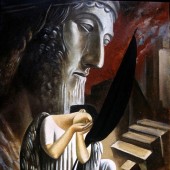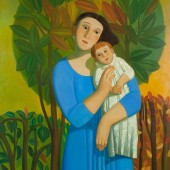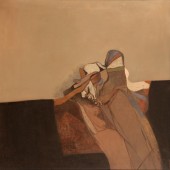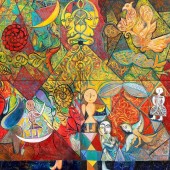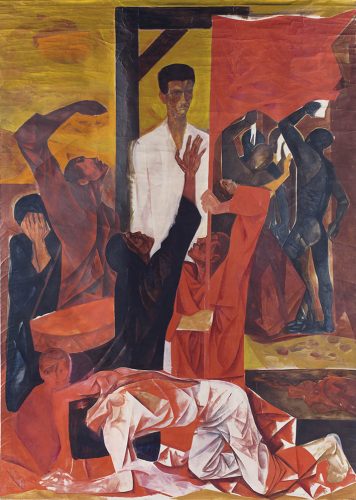
The Hero portrays the moment before the execution of the secretary of the Iraqi Communist Party, Husain Ahmad al-Radi, also known by his party name Salam Adil. This hero, facing execution, represents the demise of an ideology. The purge of Communists that ensued in Iraq after the 1963 Ba’ath-led coup d’état, had an immense impact on Sabri’s work which depicted executions of other party members. The Hero is both a tribute and a homage to his friend Salam Adil, an amateur artist, with whom he shared an interest in philosophy and art. In this painting, Sabri assimilated references from a number of visual sources such as Christian iconography and the aesthetics of social realism, and interlaced documentation with fictitious and symbolic constructions. Sabri pursued a degree in social sciences at the Loughborough University in the UK, making his artistic debut in an exhibition held at the Iraqi Embassy in London in 1947. Upon his return from the UK, he joined Société Primitive—renamed the Pioneers Group in 1950—and worked closely with the artist Faiq Hassan. Well-read in Marxist thought on art and culture, Sabri himself was an active writer and an advocate for Realism in art. Until 1959, he held a position in al-Rafidain Bank, eventually resigning to head the establishment of Iraq’s Exhibitions Department and to set up the first international exhibition in Baghdad in 1960. That same year, Sabri travelled to Moscow to study mural painting at the Surikov Art Institute under the mentorship of Aleksandr Deyneka, and in 1963, he moved to Prague to join the Committee for the Defense of the Iraqi People and began his research on the relationship between social development and the application of science in art. He published the Manifesto of the New Art of Quantum Realism (QR). Sabri left Iraq and died in Maidenhead, UK in 2012.
تصور لوحة “البطل” اللحظة التي سبقت إعدام الأمين العام الأول للحزب الشيوعي العراقي، حسين أحمد الراضي، والمعروف أيضاً من قبل حزبه باسم سلام عادل، حيث جسدت مواجهة هذا البطل للإعدام، زوال وموت عقيدة سياسية وفكرية. وقد كان لحملات التطهير التي تعرض لها الشيوعيون في العراق بعد الانقلاب الذي قاده حزب البعث عام 1963، والتي تمثلت بإعدام أعضاء الحزب ومشاهد الرثاء عليهم تأثيراً كبيراً على صبري وأعماله الفنية. لم تكن لوحة “البطل” تكريماً لزعيم سياسي فحسب، وإنما تحية لصديقه سلام عادل الذي تشارك معه اهتماماته بالفلسفة والفن، وكان هو نفسه فناناً هاوياً. في هذه اللوحة، استعان صبري بعدة مراجع من المصادر البصرية، كعلم الأيقونات المسيحية وجماليات الواقعية الاجتماعية، وإلى الوثائق المتداخلة مع التركيبات الصورية والرمزية.
حصل صبري على شهادة في العلوم الاجتماعية من جامعة لوفبور وفي المملكة المتحدة. وكان أول ظهور فني له خلال مشاركته في معرض أقيم في السفارة العراقية في لندن عام 1947. وانضم بعد عودته من لندن إلى مجموعة الفنون “جماعة البدائيين” – التي تمت تسميتها لاحقاً بـ “جماعة الرواد” في عام 1950 – حيث عمل بشكل وثيق مع الفنان فائق حسن. وقد كان صبري نفسه كاتباً فاعلاً ومدافعاً عن المذهب الواقعي في الفن، كما كان واسع الاطلاع على الفكر الماركسي في الفن والثقافة.
وحتى عام 1959، شغل صبري منصباً في “مصرف الرافدين”، ليستقيل في النهاية ويترأس إنشاء “دائرة المعارض العراقية” وإقامة المعرض الدولي الأول في بغداد عام 1960. وفي العام ذاته، سافر صبري إلى موسكو لدراسة الرسم الجداري في “معهد سوريكوف للفنون التشكيلية” تحت إشراف الفنان ألكسندر دينيكا، وفي عام 1963، انتقل إلى مدينة براغ للانضمام إلى “لجنة الدفاع عن الشعب العراقي” وبدأ بحوثه عن العلاقة بين التنمية الاجتماعية وتطبيق العلم في الفن، كما نشر بيان عن فن “واقعية الكم” الجديد. غادر صبري العراق وتوفي في ميدينهيد ، المملكة المتحدة في عام 2012.




